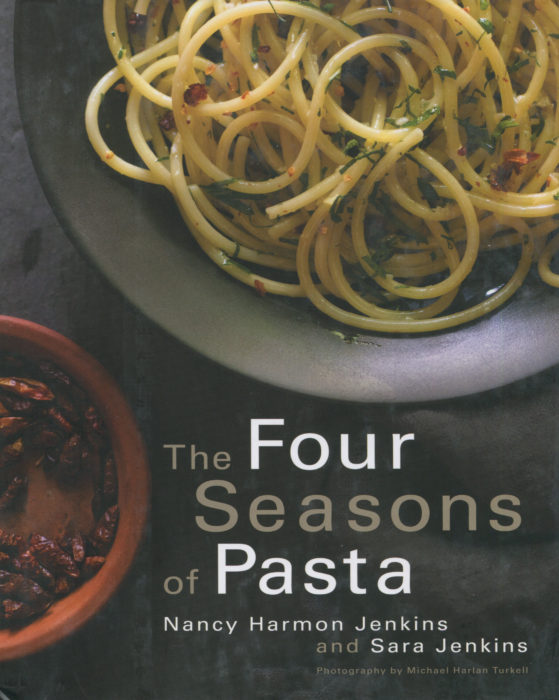
This week I am traveling and I’m taking this opportunity the let you see my favorite cookbooks of the past year. If you missed these the first time, do give them your consideration.
There are no more expert chefs and authors than The Jenkins: mom Nancy Harmon and daughter Sara. They display exceptional skills on the written page and on the plates of their restaurants. Their fondness for Italian food is based on decades of living, and eating, in Italy.
In this book, the year’s four seasons are staged with pasta recipes quite unlike the ones you may normally prepare. Recipes that are Italian inspired but that represent ideas and ingredients the Jenkins have found in the supermarkets, specialty shops, and farmers markets across America. It’s an amalgam of the pasta world, old and new, European and American. And, it is an interesting and delicious blend of both worlds.
The book begins with a long and scholarly discussion on pasta, what it is and what it is not. There are some pasta myths that go by the wayside here. Italy, land of pasta? No, actually, bread was the common daily starch and pasta was, until mass industrialization, often a rarity on the Italian table. Fresh pasta all the time? No, that fresh eggy sfoglia is far less eaten in Italy and very rarely in the south.
This book focuses on artisanal dried pasta. Ones made with bronze dies, not commercial Teflon, for the bronze induces roughness that lets sauces bond differently and better to each pasta strand. And artisanal pasta is dried more slowly than mass manufactured pasta, resulting in a different color and texture.
Myths put aside, there is a long discussion on ingredients, particularly Italian flour versus what we have readily available in America. If you want Italian-tasting pasta, then the adjustments you need to make are presented. And there is an explanation of the other key ingredients and how they differ between America and Italy: the olive oil, the capers, the olives themselves. The details of how to make pasta and dry it and cook it are given in full hand-holding detail.
If you have ever traveled to Italy, eaten pasta and said, “This is better,” then The Four Seasons of Pasta explains why.
Background work finished, it is on to the recipes. The introductory discussion of each of the four seasons is perhaps reason enough to buy this book. It’s perfectly on target describing the joys and challenges of each evolving season.
Here are the opening words for the first chapter, Winter: “Of all the seasons, winter is the hardest to love.” The Winter recipes are hearty and dense with flavor. Meat is readily available in this season for butchering pigs. The recipes are complex using the stored flavors of spring, summer and fall:
Spaghetti with Garlic, Oil and Hot Chiles
Neapolitan Christmas Eve Spaghetti with Walnuts
Pasta with Chickpeas, Pancetta, Garlic, and Escarole
Tuscan Wild Mushroom and Sausage Ragu with Sagna Riccia
Simple Pork Ragu
Spring means what else: peas and other spring delights:
Pasta and Parmesan Broth with Peas and Pea Shoots
Tagliatelle with Grilled Asparagus, Goat Cheese, and Crisp Prosciutto
Fresh Herb-Ricotta Gnudi with Brown Butter and Sage
Green Nettle Lasagna
Chicken Liver Ragu
Summer is the “brilliant time of year.” Summer is red with tomatoes:
Pennette with Ricotta and Fresh Raw Tomatoes
Pasta with Roasted Eggplant Tomato
Pasta Handles with Long Green Beans and Tomatoes
Cavatappi with Roasted Peppers, Anchovies, Garlic and Capers
Finally, Autumn brings the abundance of flavors that have spent a half a year or more absorbing sunlight and generating flavors. Truffles appear, root vegetables abound, basil is replaced by sage and rosemary:
Pasta with Crumbled Sausage, Sage, and Winter Squash
Chestnut Agnolotti with Brown Butter, Sage and Fennel
Tagliatelle with Gorgonzola Cream and Fresh Walnuts
Braised Rabbit Ragu with Red Wine, Olives and Capers
You see the word “spectrum” used to connote diversity. And often it is a “wide spectrum.” The Four Seasons of Pasta is widest of spectrums, boldly and happily presented for your consideration. There isn’t a recipe in this book that you won’t consider making. You could do this book in one year of four seasons, but it might just take you longer. These meals are “special” in the best sense of the word. The Four Seasons of Pasta will be a year-round delight.
